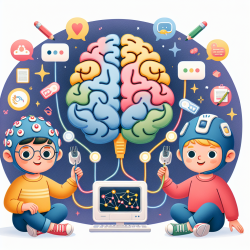Introduction
As speech-language pathologists, we are continually seeking methods to enhance our practice and improve outcomes for children with language disorders. A recent systematic review titled Functional Brain Connectivity of Language Functions in Children Revealed by EEG and MEG provides valuable insights into the use of electroencephalography (EEG) and magnetoencephalography (MEG) in understanding the neural underpinnings of language development in children. This review synthesizes findings from 24 studies and offers a comprehensive overview of the methodologies and outcomes related to functional connectivity (FC) and effective connectivity (EC) in pediatric populations.
Understanding Functional Connectivity
Functional connectivity refers to the statistical relationships between cerebral signals over time, while effective connectivity delves deeper into causal relationships between brain regions. The review highlights that EEG and MEG, with their superior temporal resolution, are particularly suited for investigating the rapid processes involved in language functions, such as auditory and speech processing.
Key Findings
The review underscores several critical findings:
- Theta Band Importance: Theta oscillations are crucial in language development, with greater left hemisphere coherence in early childhood associated with higher language functioning.
- Age-Related Changes: As children age, there is a shift from slow-wave activity (theta) to higher frequencies (alpha, beta, gamma), reflecting brain maturation.
- Left Hemisphere Lateralization: Left lateralization of language networks is evident even before the age of five, with greater left connectivity correlating with better language abilities.
- Clinical Populations: In children with language disorders, such as autism spectrum disorder (ASD) and dyslexia, atypical connectivity patterns are observed, often involving increased right hemisphere activity.
Implications for Practice
These findings have significant implications for practitioners:
- Understanding the role of different frequency bands can inform targeted interventions that align with the child's developmental stage.
- EEG and MEG can be used to identify atypical connectivity patterns, potentially serving as early markers for language disorders.
- Interventions could be tailored to enhance left hemisphere connectivity, which is associated with better language outcomes.
Encouraging Further Research
While the review provides a robust foundation, it also highlights the need for further research. Studies with larger sample sizes and longitudinal designs are necessary to establish normative data and refine our understanding of language network development. Additionally, exploring the use of effective connectivity measures could offer deeper insights into the directionality of information flow in language networks.
For practitioners interested in delving deeper into the methodologies and findings, the original research paper offers a wealth of information and can be accessed here: Functional Brain Connectivity of Language Functions in Children Revealed by EEG and MEG: A Systematic Review.
Conclusion
By integrating EEG and MEG insights into our practice, we can enhance our understanding of the neural mechanisms underlying language development and tailor interventions to foster better outcomes for children. The potential to identify early markers of language disorders and intervene accordingly is a promising avenue for improving the quality of life for children with language challenges.










